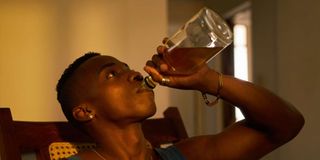Anti-liquor campaigns in Central pay off

A young man drinks alcohol at home. Central Kenya now has one of the lowest alcohol consumption rates in the country.
What you need to know:
- Technology has played a role in reducing alcoholism in Central, even as other parts of the country sink deeper into consumption.
- Central Kenya has the second lowest rate at 8.3 per cent after North Eastern with 1.4.
Nairobi has the highest rate of alcohol-related disorder cases at 18.4 per cent, followed by Western (13.1 per cent) while Eastern stands at 10.6.
Central Kenya now has one of the lowest alcohol consumption rates in the country, highlighting the success of ongoing campaigns.
The National Campaign Against Drug Abuse (Nacada) says Central has a significantly low prevalence rate compared to Nairobi and other regions.
Technology has played a role in reducing alcoholism in Central, even as other parts of the country sink deeper into consumption.
“With aggressive drives, we have noticed a sharp drop in alcoholism in the region,” Nacada chief executive Victor Okioma said.
The agency, however, added that at least 6.3 million Kenyans are regular users of liquor.
“Alcohol is the leading substance being abused, with a 12.2 per cent prevalence. About 10 per cent of substance-related disorders are as a result of alcohol,” the Nacada boss said.
Alcohol-related disorder
Central Kenya has the second lowest rate at 8.3 per cent after North Eastern with 1.4.
Nairobi has the highest rate of alcohol-related disorder cases at 18.4 per cent, followed by Western (13.1 per cent) while Eastern stands at 10.6.
Central Regional Commissioner Wilfred Nyagwanga said drone technology has greatly contributed to the fall in the sale and consumption of alcohol.
“Thanks to Nacada, we adopted the technology in fighting the menace. We can now survey large areas and pinpoint the dens on the banks of River Chania. Administrators have been of great help,” Mr Nyagwanga said.
Alcohol consumption in rural Kenya has been on the rise, with a prevalence rate of 29.6 per cent, compared to 31.7 per cent in towns.
The government ordered a major crackdown in 2015 that led to the destruction of tonnes of illicit alcohol and selling premises.
The mop-up was intensified two years ago with the formation of a team in the Interior ministry.
The team has personnel from the national government administration office, the National Police Service, Kenya Revenue Authority and the Kenya Bureau of Standards.
Adulterated alcohol
The second crackdown extended to adulterated alcohol and counterfeit premium brands.
Interior Principal Secretary Karanja Kibicho admitted in June that the country had lost an estimated 100,000 people to alcoholism since 2014.
“We have instructed our officers to enforce laws that regulate trade in alcohol. We have also directed them to dismantle networks that deal in narcotics,” Dr Kibicho said.
The PS added that he had instructed county commissioners to ensure alcoholism is not glorified.
A 2018 report attributed four out 100 deaths in Kenya in 2016 to alcoholism.
A World Health Organization report also showed that alcohol use had become alarmingly routine among children.




